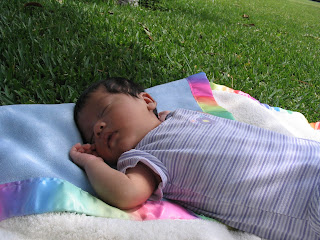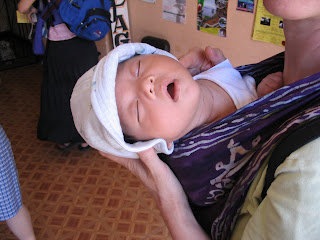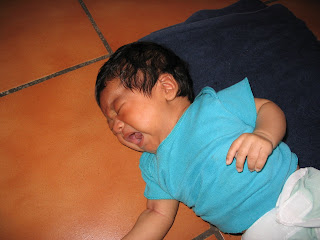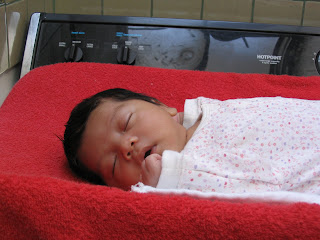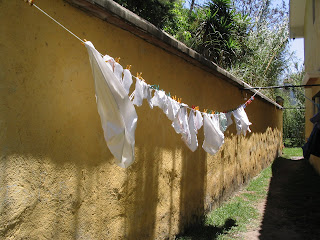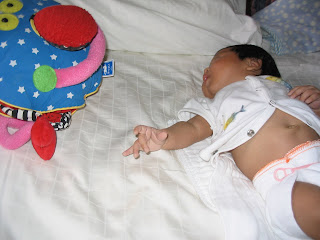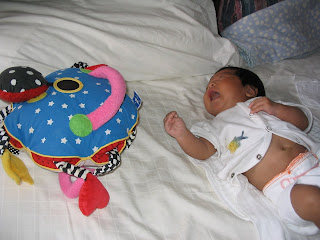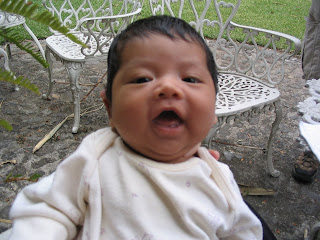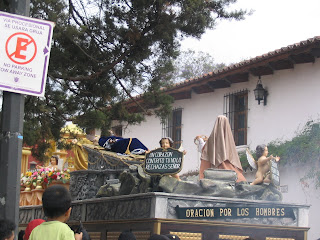the feet
My friend/cousin/neighbor adopted from Guatemala, and they just went down for a few days to pick up the child. Why are you there for so long?
Most children coming home from Guatemala are 6-8 months old (it used to be more like 3-6 months, but the process has become longer for various reasons). For many adopting parents, it makes logistical, financial, and sometimes emotional sense to wait until the adoption is finalized to join their child, although many do visit before the final pick-up trip. One of the most appealing facets of the Guatemalan system is that most adopted children are cared for in foster homes, rather than in orphanages, and often some contact is possible between the adoptive and foster families during the process. In my case, I had the even more appealing option to act as the (unofficial) foster mother thanks to the policies of my agency, the flexibility of my job, and the beneficence of my parents, so I jumped at the chance to be with my Pablito from a very early age -- I have had the great pleasure of mothering him since he was a wee bit of 2 1/2 weeks.
the chicken legs
What happens during the adoption process? Why does it take 6 months?
The full adoption process actually takes much longer than 6 months, usually, if you start counting from the beginning of the dossier collection -- the often tedious gathering of documents, signatures, notarizations, certifications, authentications etc. that are needed for an international adoption. Ask any prospective adoptive parent how the paperchase is going and you're sure to get some rolled eyes and a sigh. But I've made it through that particular hoop, and am now focussed on the Guatemalan end of the process. That consists of several different steps: from DNA day, to Family Court, to Preapproval, to PGN, to Pink. Details below.
the birthmark
What happens on DNA day?Well, first of all, I had to get up really early. Before 8. Then we got all dressed up in our Monday best, and packed a spare outfit for Pablo, just in case he spit up all over the first one. (I would have to make do, if it were my outfit that suffered that indignity.) Then Sandra and Gustavo, our trusty drivers, took us into Guatemala City (a ride that ranges from 45 minutes to 3 hours, depending on traffic), where we met Pablo's official foster mother, who then took him to meet his biological mother. The DNA test was done on both mother and baby to ensure that the baby is in fact hers, and is a safeguard in place to prevent the theft and trafficking of children for adoption. It was also the first time his birth mother had seen Pablo since she relinquished him, and was the first of four points throughout the process when she has the opportunity to change her mind. A picture of the two of them together, taken on DNA day, will be perhaps the only tangible reminder Pablo has of his first mother.
the buddha belly
What happens if the birth mother changes her mind?This happens very rarely in Guatemala, but if it did, Pablo would return to his original family. Of all the worst-case scenarios in the adoption process, this is probably the one with the least horrific consequences -- but my heart would be broken.
the hands
What happens if the DNA doesn't match?Again, this is quite rare. I don't know the exact protocol that would take place in this scenario, but my understanding is that the adoption would be terminated. I would no longer be eligible to be his mother, and I believe his care would be turned over to the state during the subsequent investigation.
the double chin
Oh my gosh -- are you nervous?In a word, yes. Not so much about the DNA per se (I should be getting the results any day now) but about the process as a whole I am nervous. Most days I don't have to think about it, and I spend my time instead falling in love with this wonderful baby boy -- but on these important procedural days, I can't help but worry about the rare disastrous possibilities, as I am reminded that he is not yet fully mine.
the profile
What happens next?The next big step in the process is Family Court. I'm still not clear about exactly what happens in Family Court, but it is essentially the social work part of the adoption. A caseworker interviews the birth mother and the official foster mother, physically inspects El Pablito, and reviews my homestudy and other paperwork. For me the inspection day began with an extremely thorough bath, and then an anxious digging through the piles of baby clothes, for the guatemaltecas are very particular about proper dress for an infant. His usual outfit of stained, unsnapped onesie and possibly some mismatched socks would not do. On DNA day I forgot to bring a blanket for him (this, in weather that ranges from 70-80 degrees), and was duly chastised. For Family Court, he had two blankets. But, shockingly, no undershirt. Once again, duly chastised.
the Spock ear
Well, that sounds pretty thorough -- what else can there be besides Family Court?Oh, all sorts of things! First of all, there is Preapproval, which is issued by the U.S. Embassy after they receive the DNA results and look over the requisite paperwork. Preapproval is the U.S. government's way of saying "yes, it looks like we'll probably be able to issue a visa for this kid once you make it through the Guatemalan end of the system." Preapproval used to take about a month -- but because of recent "increased scrutiny" it's taking twice that long. Back to the Guatemalan side of the red tape, the next step after Family Court is the big one -- PGN.
the hair
What is PGN?Ah, PGN: The Procuraduria General de la Nacion. Basically the Guatemalan Attorney General's Office. These guys look over all the paperwork (are your eyes beginning to glaze over here?), and, hopefully, proclaim that the adoption is all in order and proclaim that Pablo is mine forever. By law, this process is supposed to take 3 days. In reality, it usually takes 2-3 months, sometimes more. And PGN is where the dreaded previo, or kickout, can be issued for pretty much anything. And I do mean anything. Perhaps the reviewer prefers blue ink to black on the medical letter that it took me over a month to extract from my doctor back in the States. Perhaps someone has a missing middle initial somewhere, or an inconsistently accented name. Perhaps a page has been dogeared. Or perhaps there is a Guatemalan document that requires a signature by a mayor no longer in office (for details on that particular nightmare situation, visit www.sunflowersandladybugs.com and/or www.jesuswasnotarepublican.blogspot.com)
the smile
So, once you make it through PGN, that's it, right? You get to come home after that?
Well, not quite so fast. PGN is the end of the Guatemalan process; on the U.S. side, there's still quite a few details to be wrapped up. A visit to the Embassy doctor; the issuance of a new birth certificate; the final signing off by the birth mother; and finally, "Pink!" -- an appointment for the final Embassy visit to pick up the baby's visa to the U.S. (so known because the color of the appointment slip is -- you guessed it -- pink). All told, another 4-6 weeks after exiting PGN. But yes -- making it through PGN lets everyone breathe a huge sigh of relief. I very much look forward to that day, but it's still a long way off at this point!
the happy mama













